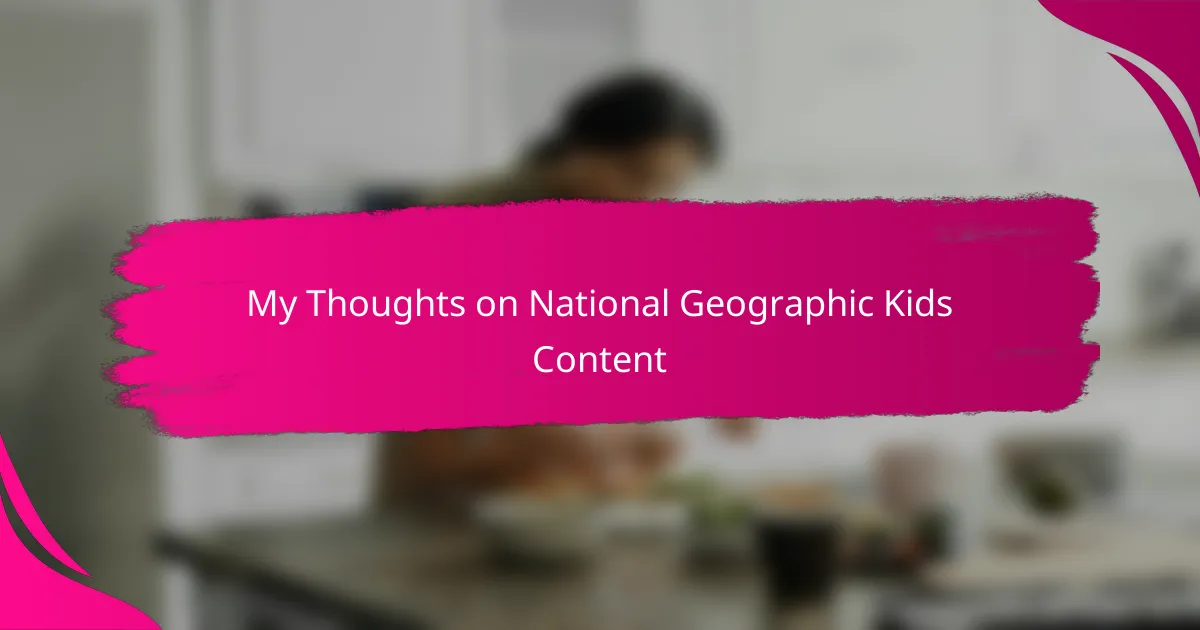Key takeaways
- National Geographic Kids effectively combines education and entertainment, fostering curiosity and a love for learning in children.
- The platform encourages hands-on exploration, helping kids connect with subjects through engaging stories and vivid visuals.
- Quality educational content shapes children’s understanding, critical thinking, and values such as empathy and responsibility.
- Parental involvement enhances media consumption, turning content into interactive experiences and encouraging meaningful conversations.
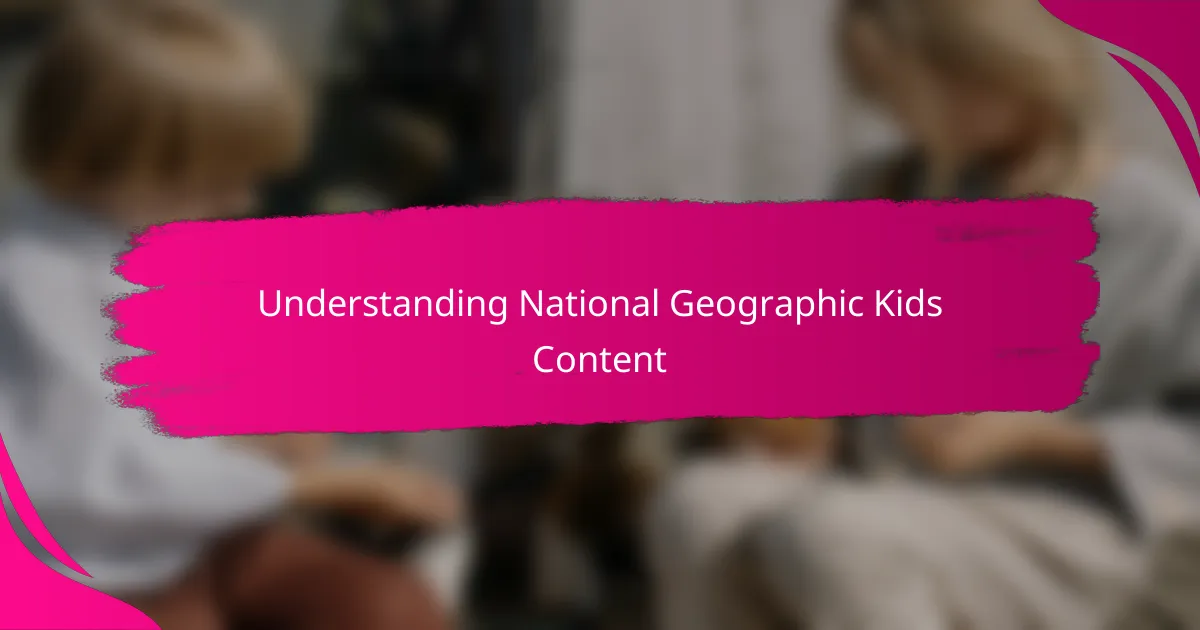
Understanding National Geographic Kids Content
When I first introduced my child to National Geographic Kids, I was drawn to the way the content blends education with captivating visuals. It’s not just about facts; it’s about sparking wonder and curiosity in young minds, which I find crucial for their learning journey. Have you noticed how easily kids get hooked on animals, planets, and cultures when the information is presented in such vivid and accessible ways?
One thing that stood out to me is the balance National Geographic Kids strikes between entertainment and education. The videos, articles, and interactive features are designed to make complex subjects like science and geography feel approachable. I’ve seen my child’s enthusiasm grow simply because the content respects their intelligence while keeping things fun.
What impresses me the most is how the content encourages kids to explore the world beyond their immediate surroundings. It’s like opening a window to endless possibilities, which is vital in today’s globalized society. Have you ever wondered how media can shape a child’s worldview? National Geographic Kids does this gently but effectively, nurturing a lifelong love of learning.
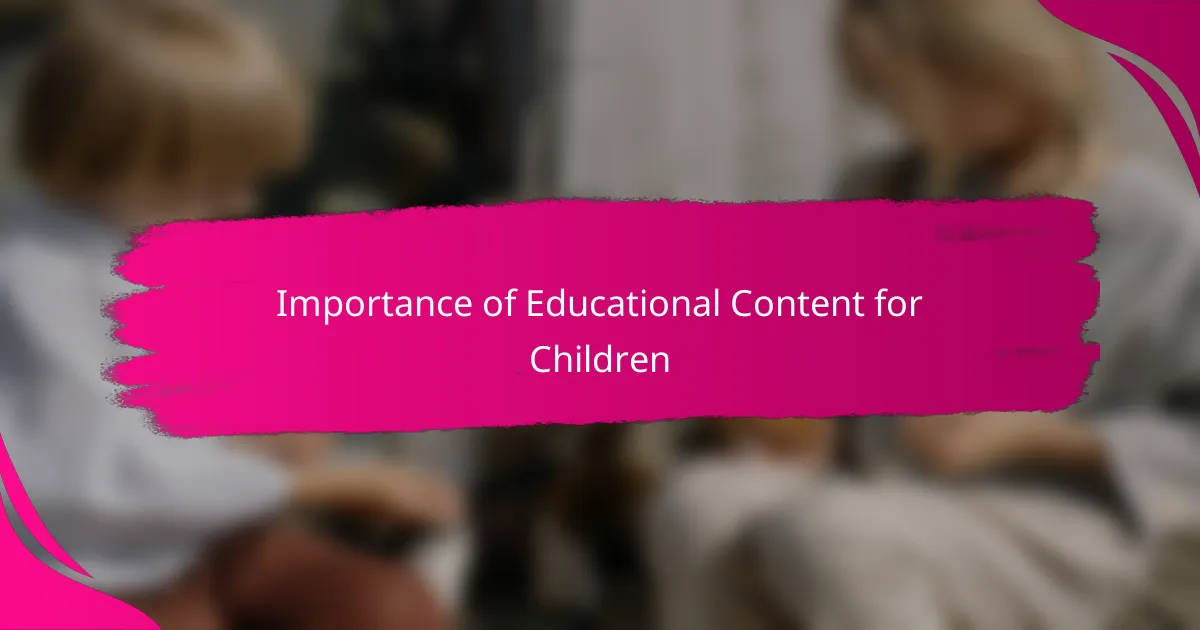
Importance of Educational Content for Children
Educational content plays a vital role in shaping how children understand the world. From my experience, when kids engage with material that not only informs but also captivates their imagination, their desire to learn naturally deepens. Have you noticed how your child’s questions multiply after watching a well-crafted educational video? That curiosity is a sign that the content is making a real impact.
I find that educational content also helps build critical thinking skills early on. When children explore topics through thoughtful explanations and vibrant storytelling, they start connecting the dots themselves instead of just memorizing facts. This makes learning more meaningful and sticks with them longer. Isn’t it rewarding to see your child puzzle through a concept and feel proud of their discovery?
Moreover, quality educational material can instill values beyond academics, like respect for nature and diverse cultures. I remember my child’s excitement after learning about endangered animals and how that prompted us to discuss conservation together. It’s moments like these that show how educational content can shape empathy and responsibility, enriching a child’s development in ways I truly value.
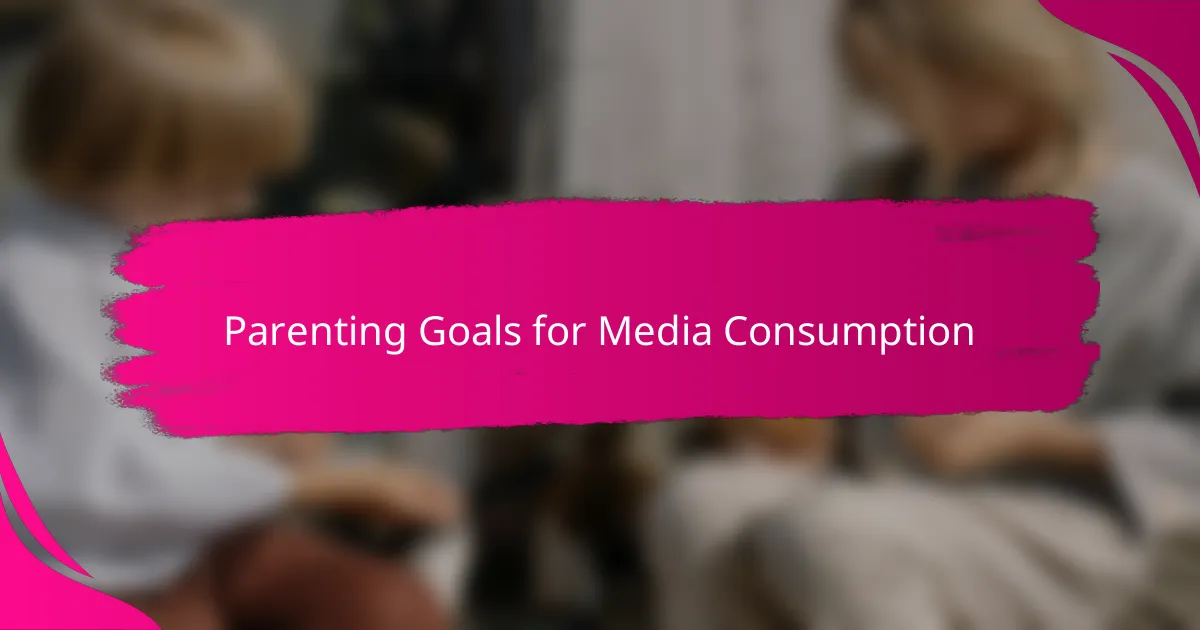
Parenting Goals for Media Consumption
Setting clear goals for media consumption has always been a priority for me as a parent. I want my child not just to be entertained, but to emerge from screen time with new knowledge and inspiration. Have you ever felt unsure about how much media is “just right”? For me, balancing quality and quantity became the key.
I like to think of media as a tool for growth rather than a simple distraction. That means helping my child choose content that stimulates curiosity and encourages questions. When we discuss what they’ve watched, it feels like those moments really solidify learning and make media time more intentional.
It’s also important to me that media supports values I want my child to develop. I’ve seen how thoughtful programming can spark empathy or a sense of responsibility—something I intentionally look for when selecting shows or sites. What kind of impact do you hope media has on your child’s character? This question often guides my choices.
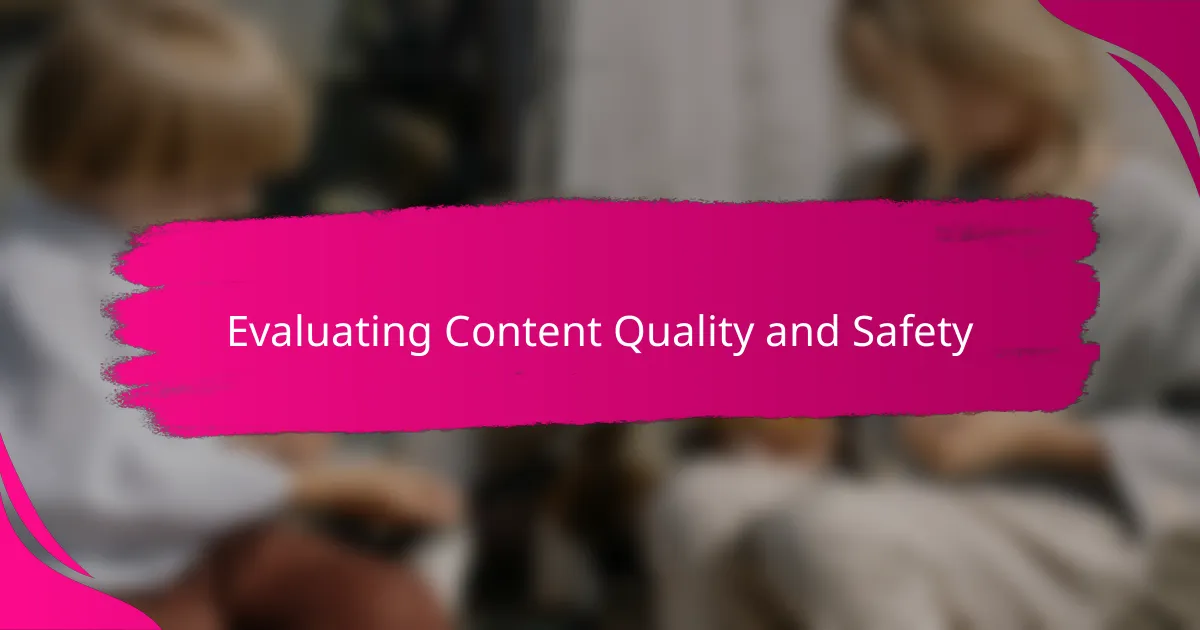
Evaluating Content Quality and Safety
When I first evaluated National Geographic Kids for quality, what reassured me most was the accuracy and depth of their information. As a parent, I want to trust that what my child is learning is not just interesting but also factually sound. Have you ever hesitated over a source because it seemed too simplistic or possibly misleading? This content consistently proved reliable, which gave me peace of mind.
Safety is another big concern for me, especially online. I appreciated how National Geographic Kids maintains a kid-friendly environment free from inappropriate ads or content. It felt like a safe digital space where my child could explore without me constantly hovering, which is a rare find these days. Don’t we all want a balance between supervision and independence?
Yet, I always stay alert to how content might influence my child’s views, looking for messages that align with positive values. I noticed that National Geographic Kids promotes respect for nature and different cultures without bias, which matches what I aim to teach at home. Have you caught subtle lessons about kindness or responsibility in the media your child uses? That’s the kind of impact I look for, and this platform delivers it well.
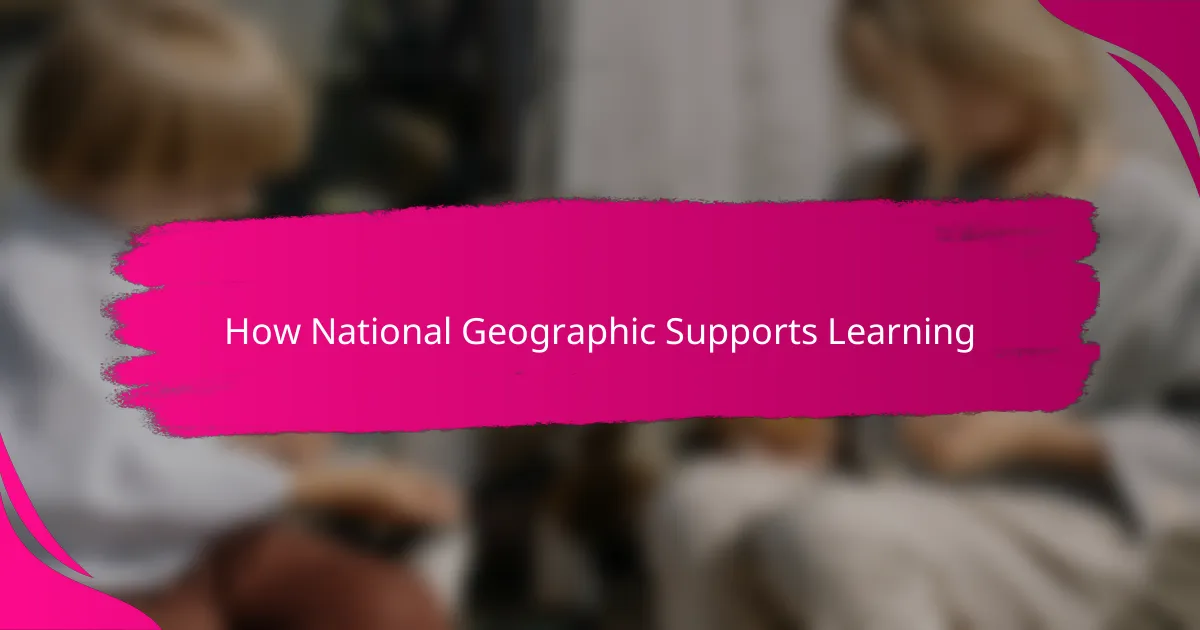
How National Geographic Supports Learning
What really stands out to me about National Geographic Kids is how it makes learning feel like an adventure. The way they use stunning images and engaging stories helps my child connect with topics in a way that feels natural and exciting. Have you ever noticed how kids remember something better when they’re genuinely fascinated by it? That’s exactly what happens here.
I also appreciate how the content encourages hands-on learning. My child often wants to try experiments or look up more information after watching a video or reading an article. This kind of active curiosity is what I believe true learning is all about. Isn’t it great when education inspires action rather than just passive watching?
Another aspect I value is the variety of subjects covered. From wildlife to space exploration, National Geographic Kids opens doors to new worlds that my child might not encounter otherwise. This diverse exposure not only broadens knowledge but also sparks empathy and respect for our planet and its inhabitants. Have you seen how a child’s perspective can change after discovering how connected everything is? That’s a powerful outcome of good educational content.
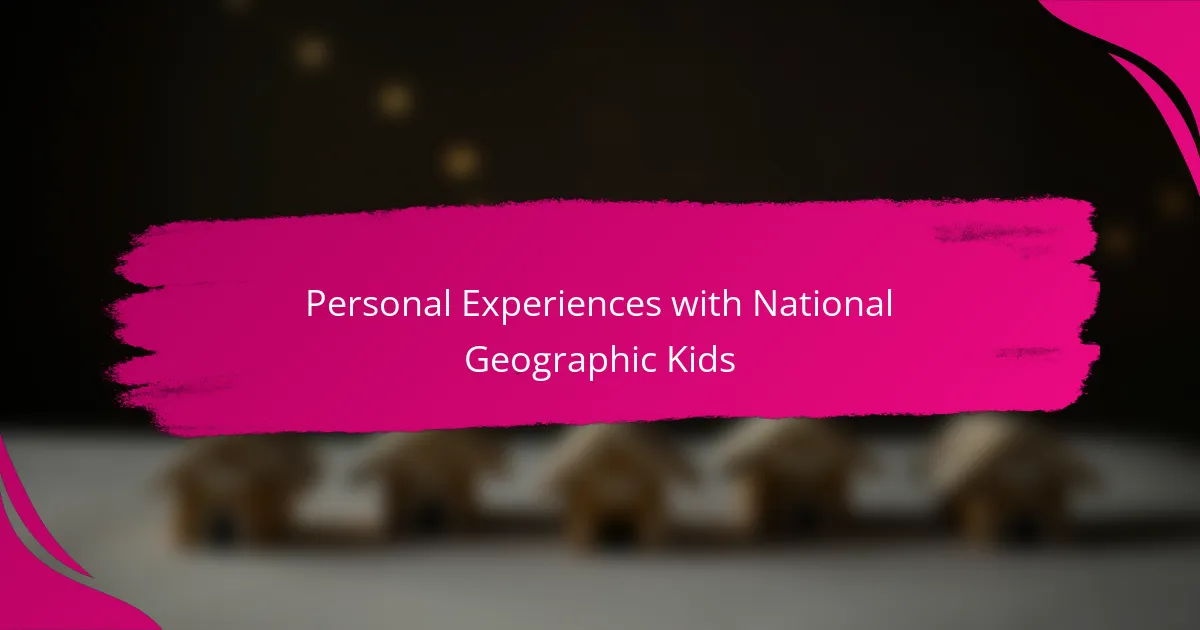
Personal Experiences with National Geographic Kids
One moment that sticks with me is when my child excitedly shared facts about the monarch butterfly migration after watching a National Geographic Kids segment. It wasn’t just rote memorization; I could see genuine awe and a desire to know more. Have you ever witnessed that spark when your child connects emotionally to what they’re learning? It’s a subtle but powerful sign that the content truly resonates.
I’ve also noticed that National Geographic Kids often becomes a starting point for our family conversations. For instance, after exploring a series on underwater creatures, my child asked thoughtful questions about ocean pollution and what we could do to help. Moments like these remind me how engaging content can extend beyond the screen and encourage real-world reflection. Doesn’t it feel rewarding when media nudges children toward empathy and responsibility?
Sometimes, the impact goes beyond learning facts—it shapes attitudes. I remember my child’s surprise when they learned that some animals adapt in unexpected ways to survive. That sense of wonder translated into a deeper appreciation for nature’s resilience. Have you found that such discoveries help nurture patience and respect in your child? From what I’ve seen, National Geographic Kids offers these meaningful experiences consistently.
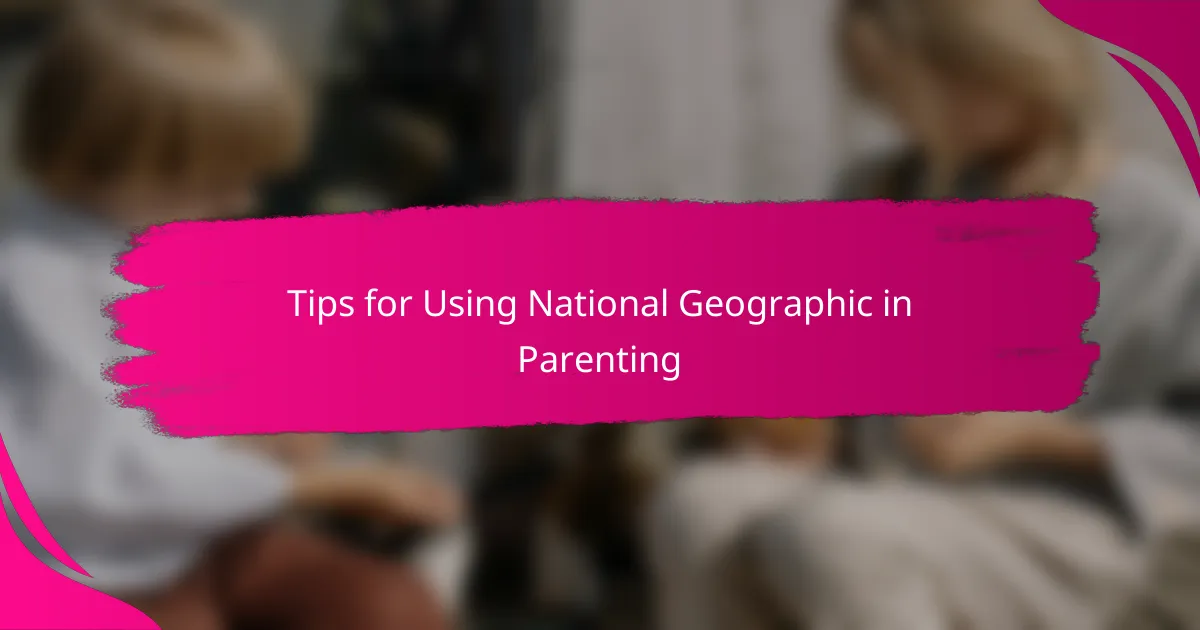
Tips for Using National Geographic in Parenting
One tip I’ve found essential is to use National Geographic Kids as a springboard for conversations. After watching a video or reading an article together, I ask my child what amazed them most or if they have any questions. This simple habit transforms passive viewing into an interactive experience that deepens understanding and makes learning a shared adventure.
I also recommend setting time limits that feel balanced—enough to explore without overwhelming curiosity with too much information at once. From my experience, shorter, focused sessions with National Geographic Kids keep my child eager to return and discover more, rather than feeling burnt out or distracted.
Lastly, I encourage parents to incorporate hands-on activities inspired by the content. For example, after learning about animal habitats, we created a little project to build a bird feeder. It’s rewarding to see knowledge come alive through creativity, and it reinforces lessons in a way that sticks far better than screen time alone. Have you tried turning learning into a family project like this? It really makes a difference.
